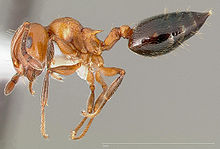Crematogaster
| Crematogaster | |
|---|---|
 |
|
| C. hespera worker | |
| Scientific classification | |
| Kingdom: | Animalia |
| Phylum: | Arthropoda |
| Class: | Insecta |
| Order: | Hymenoptera |
| Family: | Formicidae |
| Subfamily: | Myrmicinae |
| Tribe: | Crematogastrini |
| Genus: |
Crematogaster Lund, 1831 |
| Diversity | |
| > 420 species | |
Crematogaster is an ecologically diverse genus of ants found worldwide, which are characterised by a distinctive heart-shaped gaster (abdomen), which gives them one of their common names, the Saint Valentine ant. Members of this genus are also known as cocktail ants because of their habit of raising their abdomens when alarmed. Most species are arboreal. These ants are sometimes known as acrobat ants.
Acrobat ants acquire food largely through predation of other insects, like wasps. They use venom to stun their prey and a complex trail-laying process to lead comrades to food sources. Like many social insects, they reproduce in nuptial flights and the queen stores sperm as she starts a new nest.
Acrobat ants hunt both large and small prey. When it is time to hunt, foragers will typically recruit nearby ants to assist them. The ants can mark and detect their prey by specific contact. When they make contact, they immediately attack, sometimes releasing a small amount of venom with a sting. They also release an alarm pheromone to alert still more workers that prey has been seized. If other workers are present, the ants will "spread-eagle" the prey. When the prey is spread-eagled, all limbs are outstretched and it is carried along the backsides of the ants. The ants carry arolia, pad-like projections that are used to carry the prey back to the nest. These arolia are critical because acrobat ants are arboreal and will often need to travel up trees to return to their nesting location. If the prey is small and there is only one ant, it can carry the prey individually. If other workers are present, the ant will recruit carrying assistance, even if the prey is small. Acrobat ants typically eat grasshoppers, termites, wasps and other small insects.
Acrobat ants are known to eat different types of wasps. Many of these wasps have mutualistic relationships with trees involving pollination. Additionally, the wasps typically have cycles which they follow, which can make it difficult for them to be located and captured by the ants. As a result, acrobat ants have evolved unique characteristics to detect the presence of prey. They have become sensitive to chemical signals that are released by wasps and use these signals as cues in the location of their prey.
...
Wikipedia
